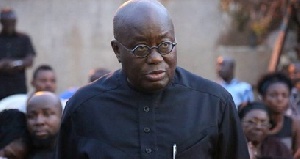- Home - News
- TWI News | TV
- Polls
- Year In Review
- News Archive
- Crime & Punishment
- Politics
- Regional
- Editorial
- Health
- Ghanaians Abroad
- Tabloid
- Africa
- Religion
- Election 2020
- Coronavirus
- News Videos | TV
- Photo Archives
- News Headlines
- Press Release
Opinions of Tuesday, 14 February 2017
Columnist: Nicholas Issaka Gbana
Mr. President, rethink creation of new regions
By: Nicholas Issaka Gbana
What do the good people of the newly proposed regions in Ghana want?
It is development - good roads, good schools, good health care, good drinking water, stable and affordable electricity, economic opportunity and jobs.
Can these be delivered by thePresident and his administration without the creation of new regions as promised in the NPP 2016 manifesto and confirmed by thePresident’s appointment of Honorable Dan Botwe as Minister for Regional Reorganisation and Development?
The answer is a resounding yes.
What is required is a paradigm shift in the thinking by our politicians, public servants, chiefs, academics and civil society groups.
The Story of Partitioning the Northern Region Whilst campaigning for the 2008 general election, then NPP presidential candidate Nana Akuffo Addo and then NDC presidential running mate John Mahama both promised to split the Northern region into two. They made these commitments at separate occasions to the late YagbonwuraBawaDoshi (King of the Gonjas) at his palace in Damongo.
This campaign pledge by the NPP and NDC was driven by a long-standing demand from the indigenes and residents of the Western part of the Northern region that development was skewed towards the Eastern part of the Northern region around the Tamale metropolis and towns like Savelugu, Walewale, and Yendi.
The Gonjaland Youth Association, for instance, had made the partitioning of the region a recurring theme at its yearly congress. In October 2009 the Northern Region House of Chiefs presented a resolution for the creation of a new region to then Vice President Mahama at the Osu Castle.
The principal arguments for this demand are accelerated development and administration efficiency, given the size of the Northern region and the fact that it covered about a third of the land mass of Ghana. This view was supported by past regional ministers of the Northern region who served under both the Kuffuor and Rawlings administrations.
The partitioning of the Northern region did not happen but the agitations ceased because of one single intervention in January 2012.
The Mahama administration secured a $166 million grant from the African Development Bank to construct the 147.5-kilometer Fufulso-Damongo-Sawla highway in the Northern Region that connects Fufulso on the Tamale-Kumasi road to Sawla on the Wa-Kumasi road.
This project which was commissioned in August 2015 by President Mahama included the construction of market sheds, rehabilitation of schools and health facilities, water supply works (boreholes) and access roads to the highway.
Its social and economic benefits have included increased access to markets for agricultural products, improved education and healthcare services, and reduction in transport costs for both goods and people.
The highway has greatly improved accessibility to the major tourism sites in that corridor including the Mole National Park, the Larabanga Mystic Stone and Ancient Mosque, and the Gonja Kingdom Regalia.
There are two key lessons from this story. First, a government does not need to create a new region or district to spread development. Second, agitations for new regions or districts will cease if development is balanced within regions and districts.
There is No Free Lunch
Chapter 2 of the Constitution of Ghana (Territories of Ghana) specify the requirements for the President to create a new region, alter the boundaries of a region or provide for the merger of two or more regions. The process for doing this is long and costly.
It begins with the submission of a petition to the President, or the President acting upon his own will. This is followed by the President setting up a Commission of Inquiry upon the advice of the Council of State.
The Commission will inquire into the need to create, alter or merge regions as the case may be and submit its recommendations to the President. If the Commission establishes that the justification for doing so is inadequate that closes the matter.
Where the Commission establishes that there is adequate justification, it will recommend to the President to organize a referendum. The President will refer the recommendations on the referendum to the Electoral Commission which shall decide the mode and manner it will be conducted.
There are two conditions for the results of the referendum to be binding. First, a minimum of 50% of the persons entitled to vote on the issue should vote. Second, a minimum of 80% of those who voted should vote yes.
A third condition must be fulfilled where the referendum involves the merger of two or more regions. A minimum of 60% of the persons who voted in each of the affected regions should vote yes. If less than 60% of the voters in any of the affected regions say no, the referendum result is not binding.
The cost involved in satisfying this constitutional process will be huge. It will include the establishment and funding of a secretariat for the Commission of Inquiry, sitting allowances and travel costs of Commission members, vehicles, fuel, etc.
If we get to the stage of a referendum the Electoral Commission will require money to organize the poll in the affected districts.
With the budget deficit and arrears that the Akuffo Addo administration has inherited, I wonder where the money will be found to do all this. Even if there is money it is better spent delivering the development the people in the affected regions want.
The Mills administration set up a Commission of Inquiry into the splitting of the Northern region into two. The report of the Commission was never released to the public. My guess is that the Commission could not establish the case for such, and hence the then government quietly abandoned the idea and went on to design the Fufulso – Damongo - Sawlacorridor project, and seek financing for it.
We Will Open a Pandora’s Box
Creating new regions will open a pandora’s box of demands and agitations from various parts of the country which will assume an ethnic dimension.
Ten years from now, we should not, for instance, be surprised to hear the good people of the Northern part of the Central region which is Assin and Denkyira dominated demanding the creation of a new region for them.
Twenty years from now, neither should we be surprised to hear the good people of Krobo wanting a separate region from the Eastern region.
The Ashanti Region may remain one cohesive unit for generations because of the unifying force of the Golden Stool.
Creating new regions today will trigger a chain of events leading to the partition of Ghana.
The Case of the Unites States and Nigeria
The United States has been a union of 50 states for many years. Alaska and Hawaii were the last two states to join the Union in 1959. Since then the USA has prospered and created wealth for its citizens. It has the most powerful armed forces in the world.
In contrast, Nigeria at independence in 1960 was a federal republic of 3 regions. In 1967, the regions were replaced by 12 states by the then military government by decree. Successive governments increased the number of states to the current 38 states and the Federal Capital Territory (Abuja).
Most importantly the increase in the number of states in Nigeria has not delivered economic wellbeing and security to the ordinary Nigerian. It has rather become a huge drain on the national purse diverting resources from real economic and social development to maintaining the administrative machinery of state governments. Ghana should not travel that road.
Improve the Functioning of Metropolitan, Municipal and District Assemblies As a soon to be a resident of Ashongman, I care more about who the work of the Ga East Municipal Assembly (GEMA) than the Greater Accra Regional Coordinating Council. A competent and dedicated Municipal Chief Executive for GEMA and a good Assemblyman or woman will make a big difference in my life and those of my neighbors.
Together with my fellow residents we can petition and exert pressure on GEMA to construct culverts to improve the drainage in my area, gravel some access roads and stop the impunity of some neighbours constructing their fence walls into road areas reserved for our common use.
The work of the Greater Accra Regional Coordinating Council and the Regional Minister is remote to me. I do not see or feel any direct impact on my life. Neither do I see the benefits a resident of Bibiani, Asankragua, Juabeso, Enchi or any of the towns and communities of the proposed Western North region get from a separate region whose capital is, for instance, Sefwi-Wiawso with a Regional Coordinating Council and Regional Minister.
The real action of responding to local needs is at the District Assembly, not that at the Regional Coordinating Council. So the President should focus on getting assemblies to function better and become real development agents especially with the promised additional resources of 1 million dollars per constituency per year.
There is also the larger question of the relevance and role of Regional Coordinating Councils when Metropolitan, Municipal and District Chief Executives will be elected in the next two years as promised in the NPP election 2016 manifesto.
Why create new regions when this critical subject has not been debated and resolved?
Redefine Government Spatial Planning
For decades, spatial planning in Ghana has been defined by the thinking that the head offices of government departments and agencies and other public institutions should be based in Accra.
At the regional level, the regional hospital, regional education office, regional police command, major schools and training institutes, etc should be sited at the regional capital.
At the district level, the district hospital, district education office, senior high school, major market infrastructure, etc should sited at the district capital.
It is this approach to spatial planning that has led to uneven development at the national level, within regions, and within districts. The chunk of resources allocated to regions go to the regional capitals and surrounding towns to the neglect of other towns and communities. It is the same at the district level.
This is the underlying reason for the agitations for new districts and new regions.
The President should charge his Minister for Planning, Hon Prof George Yaw Gyan-Baffour, and the National Development Planning Commission (NDPC) to redefine government spatial planning to spread development at the national level, within regions, and within districts. This will stop the agitations for new districts and new regions.
Lastly, the President should task his Minister for Regional Reorganisation and Development, Dan Botwe to evaluate the “Fufulso-Damongo-Sawla corridor project” in the Northern region and examine how it can be adapted and replicated in the deprived parts of the Western, BrongAhafo, Northern and Volta Regions by 2020.
It is this kind of infrastructure development and implementation of manifesto pledges like One District, One Factory; One Village, One Dam; that creates economic opportunity, jobs and social development that ordinary Ghanaians (and voters) desire, not new regions per se.
The writer is a Development Worker and Management Consultant











